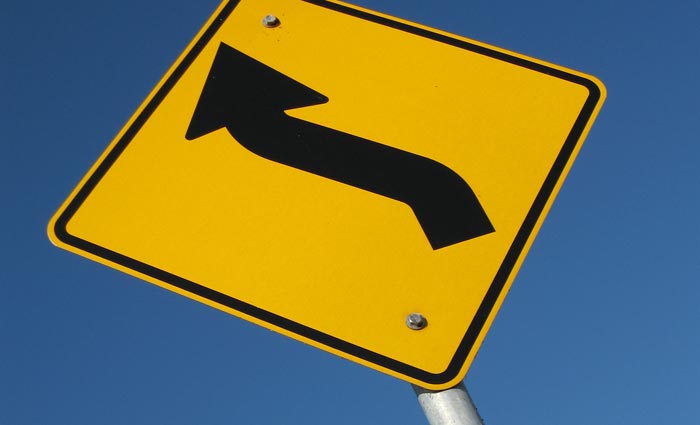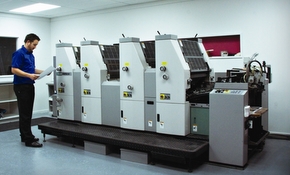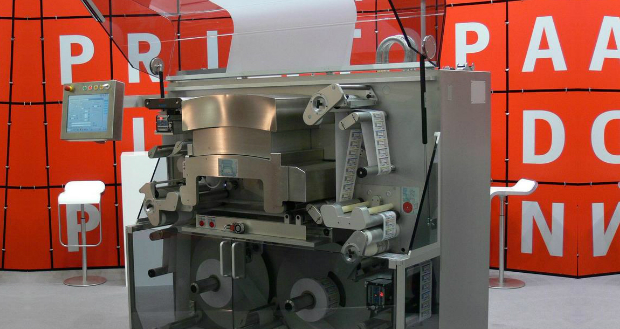
With Drupa 2012 disap-pearing in the rear vision mirror, the road ahead might have seemed clearly marked. But the signs are that most of the major press makers are reading a new map.
It was offset manufacturers’ fascination with digital technology that stole much of the limelight at the German trade show, setting off a fresh round of the old, dumb arguments between digital and offset, future and past, success and failure. Could the two printing processes come together and create a new, third way for printers?
The evidence was clear enough. Several offset and digital vendors have held talks, some have reached agreement, and a couple have even presented prototypes of “hybrid” presses that bring together the best of both worlds in a bid to provide cost-effective print products.
KBA revealed its RotaJet 76 inkjet web in March, and showed it in Düsseldorf integrated with a Muller Martini Sigma line. Konica Minolta showed its new B2 inkjet press co-developed with Komori, codenamed KM-1. This cooperation is part of a sales partnership in which the Japanese offset manufacturer will also distribute Konica Minolta’s Bizhub range.
Miyakoshi and Ryobi joined forces to show a prototype B2 digital press, based on the MD-Press 1260 continuous-feed web press that Miyakoshi demonstrated at Drupa 2008. It transfers ultra-fine liquid toner particles from a photosensitive drum to the substrate.
Ryobi was also keen to let the world know that it had sold “the world’s first fully integrated hybrid sheetfed press”, which uses Kodak Prosper S5 imprint heads on a Ryobi 750 B2 press, to Komatsu General Print Co, a Japanese commercial printer.
Do these developments signal the ascension of digital technology to the throne, or at least sharing a loveseat with offset? Australian visitors to Drupa 2012 returned with mixed impressions of this trend to hybridise print processes.
Steven Reichelt, managing director at Port Melbourne-based Blueprint Printing, points out that technology will not, of itself, deliver salvation to printers.
“What I got out of Drupa is not what I expected. I don’t think there are any magic solutions out there. Everyone’s scrambling to get some sort of digital offering together, and the basis for that is we’re all struggling in the offset market; showing us a new offset machine isn’t going to inspire anyone. They’re trying to come up with some offering to tell us that if you have
one of these, life will be better.”
Sean Downs, managing director of Colorcraft Printing in Sydney, says: “There is a shift into digital technology, and the larger manufacturers would be naïve to think that there isn’t a shift. You can tell by the number of digital machines being sold around Australia. It’s also about how you interact with your clients. It’s a lot easier to interact with a digital device than with a traditional sheetfed press.
“These new machines won’t solve the capacity problems. If you can tailor the machines to your business, which you can do with digital devices, that would be a benefit, but I don’t know which way the Heidelbergs and Komoris are going. But putting more machines on someone’s floor – I don’t think that will fix any issues.”
Attitudes change
Shane Wildash, managing director at Artvue Printing in Brookvale, noticed a real difference in attitude since his last visit to Drupa in 2004.
“The difference between 2004 and 2012 is there are a lot of manufacturers working collectively. There was a lot of prototype machinery there. The exhibitors weren’t too sure which way the industry was going, and were trying to get more information and feedback from printers about where we are going, which I thought was interesting.
The director of a Melbourne offset com-pany, who preferred to remain unnamed, comments: “Anything that drives the cost down is going to be attractive to printers. It appears that the only way for digital manufacturers to get into medium to large format and get the speed, and the only way they can challenge traditional offset printing, is some sort of hybrid machine.”
Of course, the exhibit that got the flashbulbs popping was Benny Landa’s range of ‘nano’ presses.
“For the first time, commercial printers don’t have to choose between the versatility and short-run economics of digital printing and the low cost-per-page and high productivity of offset printing. Now they can have both.”
Landa quickly signed global partnership agreements with Manroland, Heidelberg and Komori, all of whom will develop digital presses using the nanotechnology of Landa’s company, and sell and service them. It is quite a coup for Landa if his nano ink technology does in fact infiltrate the presses of these major manufacturers.
Sean Downs of Colorcraft said that while the technology he viewed at Drupa 2012 was interesting, there are other problems for technology to address beyond run lengths and print speeds.
“The Landa technology was very interesting, but the biggest problem we have in our industry is an ageing skill set, not an ageing platform to work from. With the technology they’re introducing, you don’t need to be a traditional printer to operate a device. That’s the bit I got interested in.”
Artvue’s Shane Wildash wasn’t blinded by the lights of Landa’s theatrics. “Benny Landa’s technology was interesting, but it’s got a long way to go. They had a print sheet up on the wall, and the print quality wasn’t there. I think it’s still a way off yet.”
Blueprint’s Reichelt was circumspect in his impressions of Landa’s technology. In fact, he suggests that there is another motive in Landa’s latest technology breakthrough.
“Benny Landa’s thing was very interesting. He’s no fool. My opinion is that the Landa press thing is a red herring. I very much doubt that those presses will see the light of day. I’m reading between the lines, but his background is patents – he made a lot of money out of them, and out of Indigo. He’s involved in other industries, and he realises that the click model, and the consumables, are where to make the money.
“On the one hand, the offering was the Landa press, but what he was really about was the NanoInk. He has agreements with Indigo, Komori, Heidelberg and others for this technology, but his real interest is to patent that ink, and tie up the whole concept of small ink particles so nobody else can produce them.”
Our unnamed Melbourne printer was also less than dazzled. Having viewed the presentation by Landa, he says: “It’s embryonic. Let’s see what happens. All I saw was a Komori with an iPhone stuck on top of it and a pile of crappy printed sheets.”
Gold Coast printer IBS Design Resources signed a letter of intent with Landa at Drupa 2012 to purchase a Landa press, costing between $1.5 million and $2 million, but pulled the plug on the deal at the last moment. Owner Scott Siganto says he wasn’t prepared to wait for up to three
years before a Landa press was available in Australia.
The unanswered questions hovering over all these new develop-ments are, will they ever see the bright light of commercial reality, and do they offer new opportunities for printers?
Andy Vels Jensen, managing director of Heidelberg Australia & New Zealand, is realistic in his assessment.
“Everything eventually comes to market, but some eventually fail for a host of reasons. It happens all the time; however, some products and some technology have also proven to be
game changers in the past.
“Only the future will tell. Thirty years ago, flexo was going to take over from offset, 20 years ago direct imaging on the presses was the next big thing, and 10 years ago variable data would change the world. Lately the dire predictions have been digital and inkjet killing offset within 10 years. Who knows?
“The only thing we know for certain is that there is new technology around, we should embrace what works, and in many countries it makes pure common sense, and cents, to work closely together in order to make ends meet and be able to provide a support structure to clients.”
Cost of production
Manroland Australasia managing director Steve Dunwell considers that any technology development has to deliver a real world argument for printers.
“It’s all about the ‘cost of production’ equation. What it comes down to in any of these situations in sheetfed, inkjet or web presses, is that the cost of manufacture has to continually decrease because it’s very competitive in the marketplace.
“Price pressures are going downwards and if people aren’t competitive, they’re stuffed. People still have to get the latest technology for productivity – if they don’t they’ll go backwards. If you look at the printers in trouble at the moment, it’s generally because they haven’t invested
in new technology in the past five years so their products can’t compete with current machines. They can only compete on price as opposed to what their machines can do. I think all of the technologies will be sold – print quantities won’t necessarily go up around the world but they will be maintained. All technologies will keep developing, including offset, and people will buy the presses that suit their application or need,” adds Dunwell.
Ferrostaal Australia is the local agent for Komori presses, and Rayne Simpson, general manager, Print & Print Finishing, says: “It is inevitable that the new tech-nologies will come to market, but it is also very clear that the technology will need to be thoroughly tested before it is launched. Printers will be more wary this time.
“The numerous vendor partnerships help to expedite the development of new technology to meet market changes. Both parties – litho and digital – have so much to share and gain in joint technology development. Komori showcased new tech-nology at Drupa that features tech-nology developed by Konica Minolta. The combination of inkjet head development with the precision of Komori engineering results in amazing quality and speed.
“For now, digital printing will continue to complement offset print, but digital is emerging as the platform for mainstream printing. We see that there are two reasons for this. Digital offers fast turnarounds for lower print volumes and the ability to print variable data, and it offers a much lower entry price point for printers, making it an easier decision to purchase in a tight economy,” says Simpson.
KBA was the major press manufacturer not to sign on to a partnership with Benny Landa – and with good reason, says KBA Australasia’s Dave Lewis.
“KBA realised that the other three manufacturers were going to do something with Benny Landa, and didn’t want to say ‘me too’. But I doubt if they would have in any event. I think the feeling at KBA is that there’s a lot of future left in offset, and at Drupa 2012, we definitely got that feeling more than ever.
“Ralph Samek, head of KBA Sheetfed, told us that they would monitor the situation and wait and see. They won’t rule out a digital partnership, but not yet, for at least a year or two.”
Blueprint’s Reichelt brings it all back to earth when says: “Until these devices are actually working it’s impossible to say if they’ll make a difference for printers. It’s taken a long time for digital machines to mature, and with all the inkjet hybrid technologies we’ll see the same thing happen. They’ll fill some space, but they won’t replace offset.
“Even Benny Landa said at Drupa 2012 that in 20 years’ time, offset will still be the predominant print technology.”
Comment below to have your say on this story.
If you have a news story or tip-off, get in touch at editorial@sprinter.com.au.
Sign up to the Sprinter newsletter



